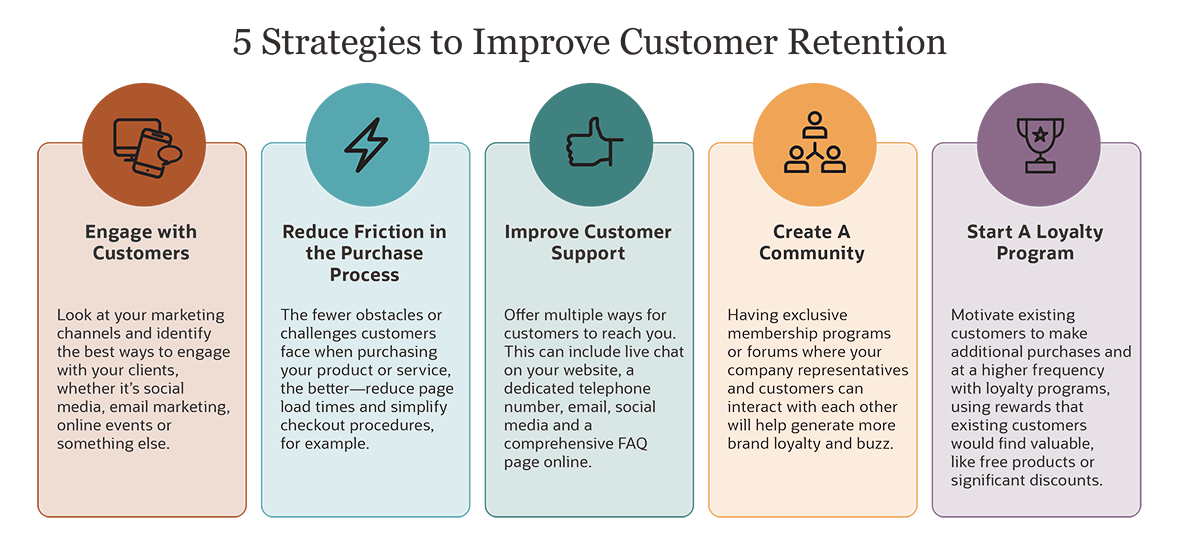Customer retention plays a crucial role in the success and lasting sustainability of a business. When done right, it can also increase a company’s profits.
The key to a high customer retention is to determine what’s causing customers to leave and then employing strategies that will build a loyal group of buyers who will buy more often and make bigger purchases. By discovering what delights and motivates your most loyal customers, you can then attempt to replicate it.
What Is Customer Retention?
Customer retention is a business’s ability to keep existing customers and continue to generate revenue from them. Companies use different tactics to convert first-time buyers into repeat shoppers. In other words, customer retention allows a business to increase the profitability of an existing customer and maximise their lifetime value (LTV).
Customer Retention Explained
Think of customer retention as a process where a business aims to convince existing customers to keep purchasing their products or services. Since a customer has already made a purchase, it’s different from lead generation, which is the effort involved in capturing contact information of businesses or individuals who are likely to buy a product or service.
Instead, customer retention is focused on existing customers. The goal is to increase repeat purchases by building customer loyalty through excellent customer service, product value and a distinct advantage over similar products or services.
Why Is Customer Retention Important?
Customer retention is vital in driving repeat purchases and ongoing value from your customer base. One oft-cited rule of thumb is that it costs five times as much to acquire a new customer as it does to retain an existing customer. Two of the most important factors in improving customer retention is understanding your customers’ satisfaction and loyalty. Businesses also need to understand any operations that may turn off potential and existing customers, such as slow or poor customer service or a faulty product.
Customer Acquisition vs. Customer Retention
Customer acquisition refers to the actions or processes designed to help a business gain new customer. This includes any efforts focused on finding new leads or turning prospects into paying customers.
Customer retention, on the other hand, happens after you acquire the customer. Once they make a purchase, you’re trying to build loyalty and drive repeat business.
Why Do Customers Leave a Company?
Customers tend to move on for a myriad of reasons, which can include poor customer service, too much friction in the buying process and a lack of perceived value. This is why it’s a good idea to map out the customer journey to know where the leaks are. It’s also a best practice to solicit customer feedback and incorporate it into the company’s larger plans.
When to Focus on Retention
The maturity of your business will determine whether you need to focus on customer retention. For instance, if your company just launched, you should focus on customer acquisition, as there are no existing clients to retain. The focal point at that stage should be developing strategies that will cultivate your initial customer base. That’s because you’re not getting any sales or customers, making it a moot point in trying to retain them. Tactics can include creating co-branded content, content produced by your business and a non-competitor, or creating a paid ad campaign.
But it doesn’t mean you can plant the seeds. Actions such as engaging with consumers and making the purchase process as frictionless as possible helps a business to gain traction. As this happens, there will be more data to look at what’s working—perhaps start tactics such as retention email campaigns or surveys. That way your business is working towards encouraging existing and past customers to make additional purchases.
Once you’re more established, you can incorporate more customer retention tactics—making it more of a priority than customer acquisition—as you start to generate more consistent sales. As your sales grow at a steady rate and you have a decent-sized customer base, you can shift more time and attention to your customer retention efforts. At this stage, things like loyalty or referral programs make sense, as you’ll have a steady (and hopefully loyal) customer base to draw from.
Benefits of Customer Retention
The main benefit of customer retention is the ability to maximise the amount of money you can extract from each customer. There are also other benefits including the following:
- Increased profits: Many companies generate the majority of their revenue from existing customers—61% of SMBs said this was the case, per a BIA/Kelsey report—so focusing on this part of your business should be the priority. It will not only increase your revenue, but also your business’s profitability.
- Lower costs: Retaining an existing customer is anywhere from 5-25 times cheaper than acquiring a new one, according to Bain & Company, so it’s a much more cost-effective strategy in the long run.
- Increased average order value (AOV): Repeat customers tend to spend more over time while increasing their average order value. That’s why just a 5% increase in retention rate can lead to profits growing 25-95%, per Bain & Company. And loyal customers are 23% more likely to buy again than others, according to a Gallup study.
- Acquire brand ambassadors: Word of mouth is one of the best ways to grow your business organically. The more loyal your customers, the more likely that they’ll share positive experiences and recommend your company to others.
Customer Retention Statistics
Here are some more statistics that demonstrate why focusing on customer retention is vital to your business:
- Poor customer service would convince 39% of people never to use a company again and 37% to change suppliers, according to research from New Voice Media.
- Temkin Group found that 77% of customers would recommend a business to a friend after having just one positive experience.
- It takes 12 positive customer experiences to make up for one negative experience, according to Ruby Newell-Legner’s “Understanding Customers.”
Measuring Customer Retention and Key Metrics
Your customer retention strategies should be guided by data beyond sales numbers that can help quantify your efforts. Let’s take a look at some of the key metrics you can use to determine your customer retention rate.
Attrition Rate Formula
The attrition rate is the number of customers a company lost in a specific time frame relative to its existing customer base. To calculate the attrition rate, take the number of customers your business lost by the end of a specified period and divide it by the total number of customers at the beginning of the period.
For example, if your business had 2,000 customers at the start of the quarter and 1,300 by the end, you’d apply the above formula as follows:
700 (number of customers lost) / 2,000 (total customers at the start of the quarter) = 0.35
This means that your attrition rate, or the percentage of customers that left during that quarter, was 35%.
Customer Retention Rate Formula
To calculate customer retention rate, determine the number of customers you acquired over a specific period. Subtract that figure from the total number of customers at the end of that period. Then you take this number and divide it by the number of customers you had at the beginning of the period.
Customer Retention
Rate
(Total customers at end of period – new customers acquired) / Customers at beginning of period * 100
For example, let’s say you have 2,000 customers at the start of the quarter and acquired another 400 customers but still have only 1,300 customers at the end of the quarter.
Customer Retention
Rate
(1,300 – 400) / 2,000 = .45
This means you’ve kept 45% of your customers over the last three months.
Repeat Customer Rate
The repeat customer rate measures the chances an existing customer will make more than one purchase.
To calculate your repeat customer rate, take the number of customers who made more than one purchase and divide it by the total number of unique customers.
For example, if you have 4,000 customers who made more than one purchase in a month and 7,500 unique customers, your formula would look like this:
4,000 / 7,500 = 0.53
This means you have a repeat customer rate of 53%.
Purchase Frequency
The purchase frequency formula is related to the repeat customer rate and represents the average number of orders placed by each customer. Take the same period used for your repeat customer rate (such as a month or quarter) and divide the total number of orders by the total number of unique customers.
Let’s say your company had 30,000 orders within a month and 7,500 unique customers. You would apply the following formula:
30,000 / 7,500 = 4
So, the average customer made four purchases.
Average Order Value (AOV)
AOV shows the average amount spent per purchase. Using the same period for the repeat purchase rate, divide your total annual revenue by the number of orders processed.
If your company earned $1,000,000 in revenue on 100,000 orders last year, your formula would look like this:
$1,000,000 / 100,000 = 10
The average value of each order was $10.
#1 CRM
In The Cloud
Customer Retention Examples
Aside from making sure you’re taking customer feedback, sending personalised email campaigns and ensuring fast response times, one of the best ways to engage and retain customers is to make them feel like they’re a part of the brand. One such example would be to allow ample time to create momentum for a new product line or new features for an existing one.
Let’s say you’ve taken customer feedback and launch a few new features that will significantly improve their user experience. What you can do is to send emails, or other forms of content marketing detailing what these features will help customers accomplish to generate buzz—both to promote an upcoming release and to show existing customers what feature they might miss. The idea is to give ample time for someone to repurchase or recommend your product or service.
Education is another great way to engage with customers. Examples include sending a series of emails that walks customers through a complex product or service after they make a purchase. Or, you can provide an opportunity for customers to schedule an online appointment where someone on your team provides a thorough consultation and answers their questions. Even a more hands-off approach like creating an online course to train new customers on a product can go a long way.
Customer Retention Rate by Industry
Customer retention rates vary widely by industry, and it’s important for businesses to understand what’s normal in their industry as they evaluate their own rate. The highest average retention rates are in the media and professional services industries, at 84%, according to the 2018 NPS® & CX Benchmarks report by CustomerGauge. The next highest rates are automotive/transportation and insurance at 83%, then IT services at 81%.
Retail and hospitality, travel and restaurants score the lowest at 63% and 55%, respectively. Clients have many options when it comes to hotels, airlines, dining and purchasing consumer goods, which might explain the lower rates in those industries. However, the report notes almost every category has businesses with a retention rate of less than 50% and higher than 95%, demonstrating that many organisations have opportunities to boost retention rate.
5 Strategies to Improve Customer Retention
Here are some practical ideas for improving customer retention:
- Engage with customers: Look at your marketing channels and identify the best ways to engage with your clients. Do they respond best to social media, email marketing, online events or something else? Let customers weigh in on upcoming products and services, so they feel like they’re part of the brand.
- Reduce friction in the purchase process: The fewer obstacles or challenges customers face when purchasing your product or service, the better. When it comes to ecommerce, fast page load times and a fast, simple checkout experience is critical. In a store, eliminate friction by making sure a staff member is always available to help a customer when they’re ready to check out.
- Improve customer support: Offer multiple ways for customers to reach you. This can include live chat on your website, a dedicated telephone number, email, social media and a comprehensive FAQ page online. Additionally, you want to ensure fast response rates. Training your staff well and measuring their performance with benchmarks will help you meet customer expectations for communication.
- Create a community: Having exclusive membership programs or forums where your company representatives and customers can interact with each other will help generate more brand loyalty and buzz. Other ideas include giving discount codes to loyal customers and creating referral programs that offer current clients an incentive.
- Start a loyalty program: Loyalty programs can be a great way to motivate existing customers to make additional purchases and at a higher frequency. Ensure that your loyalty program has rewards that existing customers would find valuable, like free products or significant discounts.

How Can a CRM System Help with Customer Retention?
A customer relationship management (CRM) system gives businesses a central view of its customers, with contact information, order history, previous communication and their response to different marketing campaigns or promotions. It offers valuable insights into their behaviour and the most effective ways to reach these customers so your company can target them with personalised offers. A CRM system also helps you see where customers are dropping off in the customer acquisition or retention process.
Choosing the Right CRM Solution
Leading CRM software has features such as lead scoring and analytics, empowering you to make better decisions that will increase conversion and customer lifetime value. Additionally, having all this information in one place improves customer service, which in turn helps convert more one-time buyers into repeat customers.
For just about any business, customer retention is an important metric to pay attention to and work to improve, especially as your organisation grows. Offering an exceptional product or service is the first step in retaining customers, and once a business has that, it should look for ways to cultivate loyalty and identify new sales opportunities within its client base.









